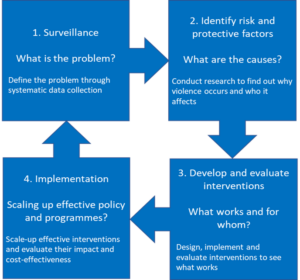Overview
How Serious Violence is managed in our area
Following public consultation in July 2019, the Government announced that it would bring forward legislation introducing a new Serious Violence Duty (SVD) on responsible authorities to ensure relevant services work together to prevent and reduce serious violence. The government also announced that it would amend the Crime and Disorder Act 1998 to ensure that serious violence is an explicit priority for Community Safety Partnerships (CSPs) and make sure they have a strategy in place to tackle violent crime.
Our area has been identified by the government as being impacted by serious violence and it has funded a Violence Reduction Unit (VRU) to tackle the long term causes of violence. The VRU brings together specialists from local government, health, police, criminal justice and fire to work as a partnership to reduce serious violence. This partnership is called the Violence Reduction Partnership (VRP).
For the first time, serious violence will be considered across district boundaries and will be analysed at Hampshire, Isle of Wight, Portsmouth and Southampton level. A Strategic Needs Assessment (SNA) will demonstrate the picture of serious violence in our area, as well as examining some of the causes of violence. The SNA will inform local strategy, which should contain bespoke solutions to prevent and reduce serious violence in the area. Read more about the SNA here.
Information on what serious violence is including our definition can be found on the what is serious violence section of this toolkit.
These root causes are complex and multi-layered. Understanding the root causes will take time, thought and cooperation to work together and bring long term solutions for future generations.
The Serious Violence Duty (SVD) focuses on tackling the root causes of violence through a programme of early interventions with young people and local communities. Statutory partners will work together to tackle serious violence and share local knowledge and data to support an evidence-based, multi-agency, ‘public health’ approach to tackling violent crime.
Tackling and preventing serious violence is complex. We know that police prosecution alone is not the answer that long-term solutions are found by partners and communities working together. The violence reduction unit in Hampshire, Isle of Wight, Portsmouth and Southampton works to bring partners and communities together and find those solutions. Evidence shows that there are key areas to create long term solutions and they are:
It is intended that Violence Reduction Units and Partnerships will change systems. We work across organisations to understand the way in which processes and approaches can be improved to reduce the risk of violence. Our key partners as defined in the SV duty are:
Specified authorities:
Hampshire and IOW constabulary
Hampshire Fire and Rescue
Justice Services – probation and Youth Justic
Health
Local Authorities
Relevant Authorities:
Education
Prisons
By bringing partners together at a strategic and operational level, we aim to tackle the problem together and strive to build more resilient and compassionate communities.
Most data in relation to crime is held by policing. We know, however, that this data will only include those crimes that have been reported to and recorded by the police, and ‘hidden’ crimes such as domestic abuse and hate crime may be underreported.
Other partners also hold data, and we work with them to understand this data and use it to inform a full picture of where serious violence is occurring. In doing this, we are able to map locations most impacted.
The VRU commissions interventions for which there is an evidence base to say they work in re. It is important to adopt policies and interventions that we know work. The Youth Endowment Fund was set up to evaluate what works with serious violence, and have produced a toolkit with their findings. This is the key organisation that we work with:
This is another area identified by the SVD that partners should work together, and this work is managed by a Comms and Engagement working group, that includes key partners. Some of the aims of this group are to:
- Promote a partnership strength based counter narrative to violence.
- Develop surveys across Hampshire, Isle of Wight, Portsmouth and Southampton to allow comparisons by community and demographic.
- Ensure the voice of the community is captured and reflected in the response to Serious violence.
- Promote and capture co-production with community based projects.
- Share consistent messages between partner organisations to tackle serious violence.
The VRP advocates a public health approach to violence. This means we consider violence as the health service would consider the spread of a disease. This focusses on understanding the root cause, targeting interventions to address those causes, considering both long-term and short-term solutions. There are several methods in which we can work together to reduce risk within our communities such as; contextual safeguarding, child-centred approach and strength-based approach. These can all work together to achieve better outcomes.
Adopting a public health approach to tackling the root causes of violence not only reduces the likelihood of individuals becoming a victim or perpetrator of violent crime, but also may improve long term health, education, and employment outcomes for individuals and across communities.[1] There may also be positive impacts for the economy and wider society.[2]
[1] Local Government Association: Public health approaches to reducing violence (2018). Available at: https://www.local.gov.uk/sites/default/files/documents/15.32%20-%20Reducing%20family%20violence_03.pdf
[2] Public Health England: A whole-system multi-agency approach to serious violence prevention (2019), Online available at: https://assets.publishing.service.gov.uk/government/uploads/system/uploads/attachment_data/file/838930/multi-agency_approach_to_serious_violence_prevention.pdf
The public health approach can be broken down into four key stages:

A public health approach aims to prevent violence with prevention measures aimed to reduce and prevent violence at a population level. The approach also involves working with partners and other organisations to develop a multi-agency response. Developing strong data and analysis is key to this.
Under a public health approach there are three levels of violence prevention. The target population decreases in size from primary towards tertiary prevention:
- Primary – focused on preventing violence before it happens; to reduce the number of new cases of violence in the population. Interventions usually target the general population or broad population groups such as young people of school age and are often aimed at increasing awareness or providing information about an issue. In Hampshire we have Choices, an PSHE education programme for years 6 and 7. More information can be found in the Practical tools section
- Secondary – groups at risk of being a victim or perpetrator of violence. Individuals are likely to already be engaging in risky behaviours and may be known to a number of services. This is an opportunity to intervene at a “reachable teachable moment” to reduce the risk of further escalation at this stage. In Hampshire, Isle of Wight, Portsmouth and Southampton area, we have A&E Navigators. More information can be found in the Practical tools section
- Tertiary – individuals already at harm or committing harm and experiencing poor health outcomes as a result. Individuals will be known to a range of services. At this level the focus is to minimise harm and prevent further involvement in violence.
- It is important to adopt policies and interventions that we know work. The Youth Endowment Fund was set up to evaluate what works with serious violence, and have produced a toolkit with their findings. This is the key organisation that we work with:Homepage | Youth Endowment Fund
To get in touch with the VRU, please email: VRU Mailbox VRU@hampshire.police.uk
